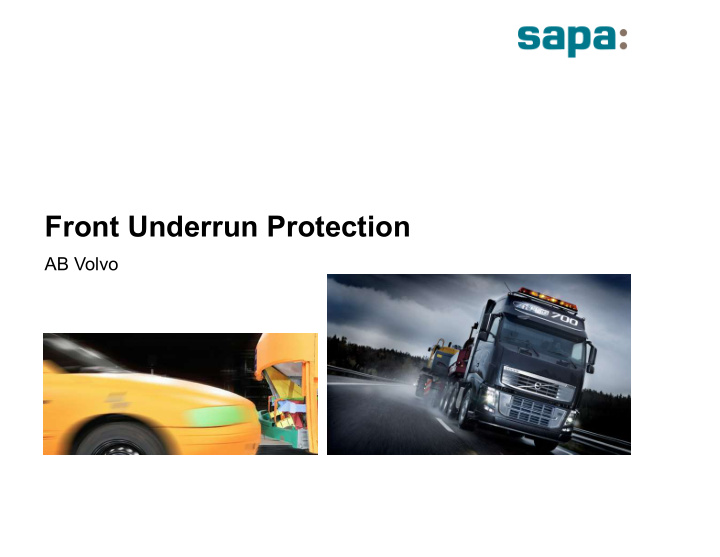



Front Underrun Protection AB Volvo
Conditions A system which is designed to ensure safety features of passanger cars are deployed during a front-on collision and prevent underrunning. The system is expected to reduce fatalities and the severity of injuries. Legal requirement ECE R-93
Legal requirement ECE R-93 Crash pads allowed to same shape as the beam. P1: Y= -1075 mm F = 80 kN P2: Y= -577 mm F = 160 kN P3: Y= 0 mm F = 80 kN Other adding requirements could be: • Increased crash requirements • Stiffness / max deflections for ie side steps • Other requirements for interfacing parts (e.g. fatigue test, more hinges for the Frontstep)
Business case – Example I Common concept within the group of different brands Brand 1 only to fulfil legal requirement Brand 2 have increased crash requirements with robustness and progressive deformation characteristic Different interfacing parts and concept between the brands The beam is common and brackets unique
Business case Customer want robustness and progressive deformation characteristic to handle collisions with cars in 70 km/h, 50% offset Crash box and shear bolts Material in the beam is steel (T=4,0 mm; Rp0,2 = 590 MPa) Material in the crash box is steel (T=3,0 mm; Rp0,2 = 350 MPa) Weight beam = 48,2 kg (+6,3 kg for brackets) Weight crash boxes = 10,6 kg
Sapa solution for the customer Fulfil the crash requirements Match all interfaces Crash box and shear bolt bracket not included EN/AW 6005A-T6 Weight beam = 20,0 kg => 60% saving (1m in front of the Front Axle) Weight brackets = 2,7 kg => 60% saving
Catia simulation Original beam in steel Sapa beam in aluminium ”Simple” simulations in Catia only on the beam to find the first draft of section design
LS Dyna simulation P1 P2 LS-dyna simulations at Sapa Technology to find the right behavoir and strengt levels
Customer simulation on complete system CAE simulations at customer on complete system/truck to verify correct behavior
Business case – Example II Same package space as current model Same interfacing part to be used Front and rear sheet in steel T=3,0 mm Weight Steel 34,8 kg
Business case – Example II Fulfil the crash requirement Match all interfaces EN/AW 6005A-T6 Material thickness between 4-8 mm Weight beam = 20,3 kg => 42% saving
Why extruded aluminium Main force is bending in x-direction All walls have not same strength requirements Disadvantages with steel Same thickness all over Advantages with Aluminium Thickness can be variated where it´s needed lower weight Ductility – crash performace … 6260 6063
Summary Sapa can find solutions fulfil all requirements Weight saving on 60% Sapa have the skills and knowledge to make complex concept solutions including simulations Work with Sapa to find a FUP solution in extruded aluminium !
Next step Proposal how to continue the cooperation between Volvo NA and Sapa: 1) Volvo NA delivers CAD model and package space from a chosen project 2) Volvo NA specifies which requirements that are valid for the FUP 3) Sapa evalutes the time and workload for a concept 4) Sapa comes up with a first draft of FUP in extruded aluminium 5) Volvo NA makes CAE simulations to verify the proposal
Recommend
More recommend